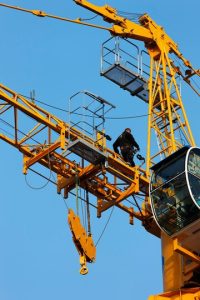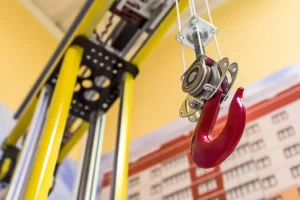Introduction
In construction and industrial settings, lifting tools are essential for moving heavy loads safely and efficiently. The selection and use of these tools must adhere to strict safety standards and best practices to prevent accidents and injuries. This detailed discussion covers the types of lifting tools available, factors to consider when selecting them, best practices for usage, and regulatory compliance.
injuries. This detailed discussion covers the types of lifting tools available, factors to consider when selecting them, best practices for usage, and regulatory compliance.
Types of Lifting Tools
- Cranes: These are heavy-duty machines designed for lifting and moving large loads. There are several types of cranes, including:
- Mobile Cranes: Versatile and can be transported to different sites.
- Tower Cranes: Often used in high-rise construction, these cranes provide significant height and load capacity.
- Overhead Cranes: Typically found in factories and warehouses, they moveloadshorizontally along a fixed path.
- Hoists: These are devices used for lifting or lowering loads. They can be manually operated or powered, with common types including:
- Electric Hoists: Ideal for repetitive lifting tasks.
- Chain Hoists: Suitable for heavy loads, often used in construction and manufacturing.
- Forklifts: These are essential for lifting and transporting materials short distances. They come in various types, including:
- Counterbalance Forklifts: Equipped with a weight at the back to counterbalance the load.
- Reach Trucks: Designed for narrow aisles and can extend their forks to lift loads.
- Lifting Beams and Spreaders: These tools are used to distribute the load evenly when lifting, minimizing the risk of tipping or swaying.
- Slings: Used in conjunction with cranes and hoists, slings are made from various materials (e.g., chain, wire rope, synthetic) and are essential for securely attaching loads.
Factors to Consider When Selecting Lifting Tools
- Load Weight and Size: Always determine the weight and dimensions of the load. Tools must be rated for loads greater than the maximum expected weight to ensure safety.
- Lift Height and Reach: Consider the height the load needs to be lifted and the distance it needs to be moved. This affects the type of crane or hoist needed.
- Environmental Conditions: Different tools are suited to various environments. For instance, electric hoists may not be ideal for wet conditions, while some forklifts are better for rough terrain.
- Frequency of Use: For tools used frequently, investing in higher-quality, durable equipment can be more cost-effective in the long run.
- Operator Skill Level: Assess the training and experience of the operators. Complex machinery requires skilled operators to minimize risk.
- Regulatory Compliance: All lifting tools must meet local and national safety regulations. It is essential to verify that equipment complies with standards set by organizations such as OSHA (Occupational Safety and Health Administration) in the United States.
Best Practices for Using Lifting Tools
- Training and Certification: Ensure that all operators are trained and certified for the equipment they will be using. Regular refresher courses can help maintain high safety standards.
- Pre-Operation Inspections: Conduct thorough inspections of lifting equipment before each use. Check for wear and tear, functionality of safety devices, and ensure that all components are in good condition.
- Load Testing: Perform load testing on new or repaired equipment to ensure it can safely handle the intended loads.
- Proper Rigging: Use appropriate rigging techniques to secure loads. This includes choosing the right type of sling, ensuring slings are not twisted or kinked, and distributing the load evenly.
- Clear Communication: Establish clear signals and communication methods among team members. Use hand signals, radios, or other means to ensure everyone is aware of lifting operations.
- Use of Spotters: In tight spaces or complex lifts, a spotter can help guide the operator and ensure safety.
- Environmental Awareness: Be mindful of the surroundings. Check for overhead obstructions, power lines, and ensure that the ground is stable.
- Load Management: Avoid overloading the equipment. Always adhere to the manufacturer’s specifications for weight limits and ensure that loads are evenly distributed.
- Emergency Procedures: Have clear emergency procedures in place. Train all personnel on how to respond in case of equipment failure or accidents.
Regulatory Compliance and Safety Standards
Lifting operations must comply with various safety regulations. In the U.S., OSHA sets guidelines for lifting equipment, while the American National Standards Institute (ANSI) provides additional standards for safe operation.
- Regular Maintenance: Schedule regular maintenance checks and repairs for all lifting equipment. Keeping machinery in good working condition is essential for safety.
- Record Keeping: Maintain detailed records of inspections, maintenance, and training. This documentation can be crucial for compliance audits and improving safety practices.
- Incident Reporting: Establish a system for reporting and investigating accidents or near misses. This can help identify hazards and improve safety protocols.
- Continuous Improvement: Regularly review and update safety practices. Encourage feedback from employees about potential safety improvements.

Conclusion
Selecting and using lifting tools in a construction environment requires careful consideration of various factors, including load weight, environmental conditions, and operator skill level. By adhering to best practices and regulatory standards, organizations can enhance safety and efficiency, reducing the risk of accidents. Continuous training, thorough inspections, and a commitment to safety are vital components of any lifting operation. Ultimately, the goal is to create a safe and productive work environment where lifting operations can be conducted efficiently and without incident.
This comprehensive approach to lifting tool safety not only protects workers but also contributes to the overall success of construction projects.

